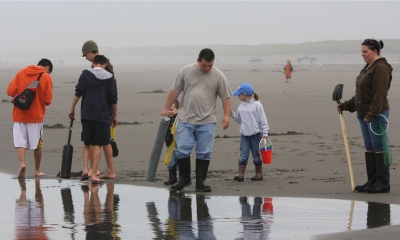
Seasonal Opportunities
Crabbing and clamming are year-round activities on the Oregon coast. Clam diggers will want to watch for low tides, when more beach is exposed for digging. Crabbers will have the best luck during slack tide when crabs are walking about foraging.
SPRING
March, April, May
Clamming and crabbing areas open all along the Oregon coast. This time of year, opportunities may depend on low tides and safe surf conditions.
After heavy rains, the influx of fresh water into bays and estuaries can temporarily chase crab into the saltier ocean waters.
SUMMER
June, July, August
Bay clamming will be the beach goer’s best bet for summer digging. Razor clamming on the Clatsop beaches – where 90 percent of Oregon’s razor clams are harvested – is closed from July 15 to Sept. 30 to protect young clams.
By mid-summer male crabs begin to molt – a process by which they shed their old shell and grow a new one. During this time, crabs are soft, with not a lot of meat.
Summer can be a good time to try surf or jetty fishing while you’re at the beach.
FALL
September, October, November
Bay clamming is open coast-wide, and the conservation closure of razor clams on Clatsop beaches ends on Sept. 30.
Fall can be some of the best crabbing of the year as crab have filled out after molting. Smaller bays and estuaries with more freshwater influence can have good crabbing from late summer to early fall. Larger bays like Tillamook, Yaquina and Coos have the best year-round opportunities. The best crabbing will be during slack tide (times of peak high or low tide) when many crab are walking around and foraging.
The ocean is closed to ALL crabbing Oct. 16 – Nov. 30.
WINTER
December, January, February
Winter storms and high seas may discourage all but the most dedicated clam diggers. However, if the seas are calm(ish) and the tides are low, clamming can be good throughout the winter.
Crabbing can continue to be good, especially in larger bays or bays with less freshwater influence like Tillamook, Yaquina and Coos. In smaller estuaries and bays, fresh water from rains and freshets can move crab further out in the ocean in search of saltier water.
Additional Resources
Check the tide table
Incoming and outgoing tides can affect several marine fisheries. For example, clamming is best during low and negative tides.
Clams and Biotoxins
Learn more about the biotoxins that occasionally shut down razor clamming, and sometimes crabbing, on the Oregon coast.
Buy a shellfish license
Fall and winter can be excellent times for crabbing and clamming. And shellfish licenses are quite affordable ($10) for youth and adults 12 and older.




